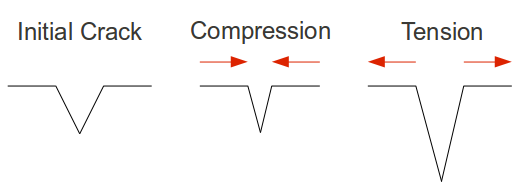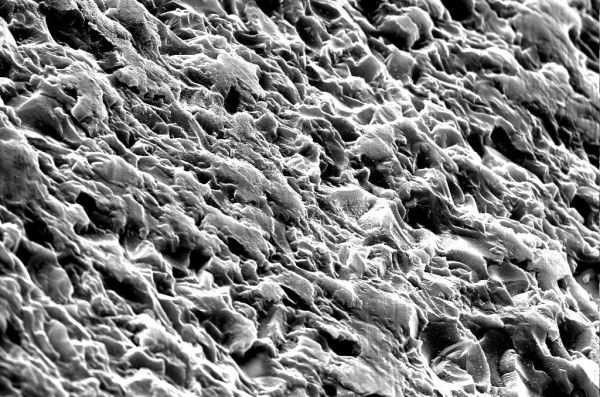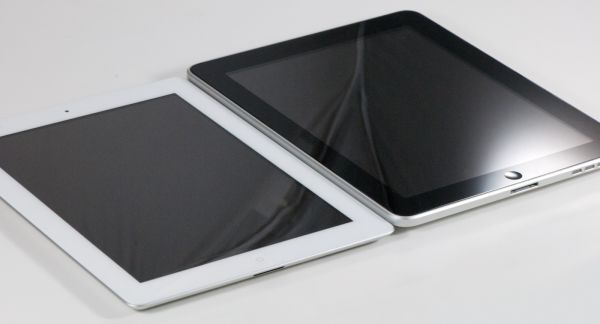The Apple iPad 2 Review
by Brian Klug, Anand Lal Shimpi & Vivek Gowri on March 19, 2011 8:01 PM ESTI asked a friend of mine, Alexander Miles, to write a bit about the properties of glass that really contribute to its overall strength after reading that the iPad 2's glass is 0.62 mm thick compared to 0.85 mm thick in the iPad 1. Hopefully this dispels some myths about glass strength and clarifies. Alex is a senior double majoring in Materials Science and Engineering and Optical Science and Engineering at the University of Arizona.
On the Strength of Glass
We usually think of things failing under compressive stress, being pushed inward from both sides until it they are crushed. Glass and ceramics, it turns out, are incredibly strong in compressive stress. Strictly by the numbers, a fire truck could be supported by a ceramic coffee cup underneath each tire, but only if the load was perfectly downward. Why then are glasses so fragile? This is because no situation causes only compressive stresses, and tensile stress (imagine pulling something from both ends) is what causes glasses to fail. One can think of tiny cracks inside the glass being pushed closed under compressive stress, but torn open under tensile stress.

A schematic illustration of crack behavior in brittle materials.
If you test the tensile strength of thousands of pieces of glass with identical processing and geometry, you will get thousands of different answers. This is markedly different from metals, where you will get nearly the same result every time. The reason being that glass and ceramic materials have a much lower fracture toughness, as much as 100 times smaller than that of a metal. Fracture toughness indicates how easily a crack can propagate, or to phrase it differently, how big a flaw will cause fracture for a given load. As the required load for normal flaw sizes in metals is enormous, metals typically do not fracture in the way glasses do. Metals usually fail in what is called plastic deformation, necking down then tearing away, long before fracture can occur. This plastic deformation is very predictable and follows the stress-strain curve for the given metal, whereas glasses are less predictable.
The question now is, how does the size of a piece of glass affect its behavior under tensile stress? It depends on the distribution of flaws within the material. If you strike a piece of glass with a hammer, a compressive stress is created right below the hammer, but a ring of tensile stress is also created around the spot you hit. You are essentially sampling the distribution of flaws, because if any of the flaws in the affected glass are big enough to widen with the stress you provided, they will rapidly propagate and the material will fracture. The stress field extends down into he material, so flaws in the volume can cause failure as well, though surface flaws are more consistently to blame as the stresses encountered there are almost always larger.

SEM image of a broken glass surface, (CC BY-NC-ND 2.0) attribution St Stev's flickr.
In glasses the distribution of failure stresses is described using Weibull statistics, giving a peak where most samples fail, and tails both on the high and low end where samples had abnormally high and low failure stresses respectively. The long and short of this is that consistently processed samples will have a more narrow distribution as the geometries are scaled down. This means that a thinner piece of glass will have fewer flaws in the bulk and far less likelihood of having a large enough flaw to cause catastrophic failure compared to a thicker piece of glass. The fact that the screens have a large aspect ratio, that is they are far thinner than they are wide or long, means that the effective stiffness will be different in the two directions. Taking this to an extreme, a very thin glass fiber is fairly flexible in bending, but very stiff axially, as its cross-section is so small that very few flaws are contained inside it. If one needs to break a glass fiber, a surface flaw is usually created by scratching it first.
| Approximate values for the strength of common soda lime glass in various conditions | |||||
| Condition | Tensile Strength (MPa) | ||||
| Theoretical Maximum (Flawless) | 9810 | ||||
| 3 Micron Fibers | 3330 | ||||
| Thin rods, fire-polished and acid etched | 3420 | ||||
| Thin rods, no special treatment | 690 | ||||
| Bulk, ion exchange tempered | 350 | ||||
| Bulk, thermally tempered | 300 | ||||
| Bulk, fire-polished and acid etched | 220 | ||||
| Bulk, no special treatment | 50 | ||||
In order to use glass screens on our devices, we would like it to be far tougher, where "tougher'' ideally means both more resistant to fracture as well as more resistant to scratching. There are two basic schemes used to strengthen glass: elimination of the surface flaws, and creation of compressive stress in the bulk of the glass. Eliminating the surface flaws by polishing, fire-polishing (heating them until surface tension flattens out the flaws), and acid-etching does indeed increase the strength, and drastically so. An increase in strength of up to one hundred times can result from such treatment, but is temporary as microscopic scratches from handling will quickly reduce the strength back to what it was before.
The second scheme for improving strength, introducing a compressive layer, works because existing compressive stress in the glass has to be overcome by the induced tensile stress before any cracks can propagate. To say it plainly, if you don't hit it hard enough with a hammer, it will not even see the type of stress that makes it fail. The down side to this method is that every force causes an equal and opposite force, meaning that a lot of compression at the surface causes tension at the center. As long as a crack does not reach the volume with the additional tensile stress imposed on it, the glass will hold together, but once it does it releases the energy kinetically and fails catastrophically (it explodes like a pumpkin with an M80 stuffed in it).
The way this layer is created varies based on the application. For car windshields, they are thermally tempered by chilling the outer surface while the center is still hot, as the surface remains solid while the center is still busy shrinking, which leaves the surface in compression. Similarly, coating the glass object in a second type of glass with a lower thermal expansion will cause the same effect, as the outer surface shrinks the center is shrinking faster. The multiple-glass approach has the additional benefit that cracks have difficultly moving from one type of glass to the next, leading Corning to produce some glasses with as many as 7 layers.
The final method, and most relevant to our discussion, is ion-exchange. Ion-exchange refers to removing small ions, like sodium, from the glass, and replacing them with larger ions like potassium, all at a temperature that prevents the structure of the glass from adjusting itself to these new bigger ions. The way this swap is actually done is by immersing the glass in a molten salt solution containing the ion we want to substitute in, and allowing it to diffuse in over time, while the smaller, more mobile, ion diffuses out. Depending upon the type of glass, the ions being exchanged, and the desired depth, this process can take as long as several days.
The iPad 2 and previous iPad both utilize Corning Gorilla Glass. This type of glass is an alkali-aluminosilicate, being primarily silica and aluminum with an alkali metal, along with other unspecified components mixed in to tweak its properties. The biggest benefit of alluminosilicate glasses, aside from being relatively tough to start with, is the fact that the rate of ion exchange is fairly high even at temperatures low enough that the structure cannot react, meaning it can be processed quickly and create deep protective layers in the glass. The iPad 2 has a modest reduction in the thickness of the glass (about 23% thinner, for those interested) compared to the first iPad, and the question of increased fracture risk has been posed. Given the identical surface quality between the two generations, the reduction of thickness should create no palpable change in toughness for the typical user. That is to say, a drop that would shatter the screen on the original iPad would likely do the same for the new model. That being said, several other design changes appear to account for the change, and might yield better performance in this department.
Where its predecessor used small metal clips to retain the glass screen, the current iteration uses a ring of adhesive around the entire perimeter that not only distributes the load around the glass and prevents scoring at the glass-metal interface, but better couples the stresses into the more compliant aluminum frame. Both of these measures should improve the performance; either way, drop-testing new electronics is generally not recommended.











189 Comments
View All Comments
name99 - Sunday, March 20, 2011 - link
"you cant be a very tech inclined person if if you think you are, if you dont know that 1.2 GHz quad core arm cortex is coming later this year and so most tech people are waiting on that to happen"Really? You're going to buy that crappy 1.2GHz quad core A9? You're not going to wait the even better 1.8GHz quad core A15 that will be available in late 2012? Sucker!
Personally I think that if you buy now, before the 802.11s wireless spec is standardized, and before the chipsets support OpenGL 6, you're just throwing your money away. But I tell you, come 2020, that's going to be one SWEET rig that I finally get round to buying.
CZroe - Sunday, March 20, 2011 - link
"Just to test it out, I shot a series of videos of my car and stitched them together using iMovie, then added some titles and a soundtrack."I found iMovie completely useless on my iPhone 4 and iPhone 3GS because I could not combine two clips/videos nor could I make a runing commentary with titles.
Are you sure that the iPad 2 version can do this or were all the "videos" in the "series" made from the same longer video?
CZroe - Sunday, March 20, 2011 - link
"Lately Apple has been trying its hand at first party case solutions. It stated with the bumper on the iPhone 4, carried over to the original iPad, and continues now with the iPad 2."When you fix that typo ("stated" instead of "started"), you may also want to correct that fact about what came first.
The iPad launched before the iPhone 4 so the official iPad case launched before the iPhone 4 bumper case, unless I somehow missed it and the official iPad case came out mid-life for the iPad.
darwiniandude - Sunday, March 20, 2011 - link
pja: The 64gb 3G version was at most $1049 AUD rrp, before the price drop, the 64gb WiFi one was $899 AUD rrp. The 64gb WiFi was never $1100 AUD unless you were looking at eBay pricing while stock was scarce. Anyway as this article states, the iPad, provided it does what you require, is a great combination of battery life, weight and size. Tablets certainly aren't for everyone though.Deepcover96: Agreed. Hopefully this changes later and I'm sure it will, but for the moment Android has a poor selection of AAA titles. Nothing like Garageband or iMovie, but certainly nothing like Infinity Blade, Nanostudio, Beatmaker 2, World of Goo etc. I'm sure Gameloft and EA will eventually do more, provided they can monitize ok on Android. And for the limitations of iOS apps, I wouldn't be able to have an iPad as my only portable device if it were not for Pages/Keynote/Numbers/TouchDraw/Photogene and so on.
CZroe: iMovie for iPhone (last year even) could do what you ask after the first update. This year it's greatly improved. A downside to this app and other Apple apps can be a lack of well known gestures. People don't know in Pages that if you hold your finger on an object, swiping with another finger moves it by one pixel, swipe with two moves it by 5 pixels, and so on. Likewise in iMovie, you swipe down through footage like you were cutting it at the playhead to make a cut. Each cut is a faultless transition, but then you can title each cut area separately. So you cut where you want the text to change, and label accordingly. In the new iMovie (only used on iPhone 4 as I sold 1st gen iPad whilst waiting for iPad2) when you import video there are standard iOS movie trim handles over the clip, you only need import the bits you want from each clip. But you could definitely always import more videos into one project in the last version. I think Apple need a modal help "Would you like to watch a short video about iMovie?" dialog or something on the first few launches with a website link, all these apps have their features tucked away so people often think they're less powerful than they are. I'm not sure Apple is choosing the best ratio of controls to expose to the user here. And yes, iPad case came out before iPhone 4, definitely.
kschaffner - Sunday, March 20, 2011 - link
An awesome free web browser for the iPad is Terra, it gives you tabs, has an incognito mode. etc I would definitely check it out.darwiniandude - Monday, March 21, 2011 - link
Thanks, I'll check it out. I only use iCab as I bought it for iPhone, it got a universal update and I've been happy enough not to bother looking elsewhere. (it does have a 'privacy' mode) also caching of pages for when you're offline. Anyway, I've downloaded Terra and will play with it on the new iPad. It looks nice.Ha, there's a Terra Incognito HD game, lol
medi01 - Monday, March 21, 2011 - link
Looking at the rounded back of ipads, ipad2 in particular, it's hard to understand, why the newer version is easier to hold.With rounded surface, they both should be harder to hold, and ip2 in particular.
darwiniandude - Monday, March 21, 2011 - link
The original had flat sides, probably about 4 or 5mm, and a giant convex back, domed in the centre. The new one is thinner, has no flat sides (the curve just falls away from the front) but it's more of a bevelled edge, and once you're about 1cm in from the edges the back is perfectly flat.Is it easier to hold? Dunno, haven't got mine yet :) But that's what people are saying.
thebeastie - Monday, March 21, 2011 - link
Everyday I use my Ipad even when I don't think about it.I use it as my wake up Radio clock via TuneIn Radio app. This app is great as I can go to sleep with the timer and then wake up to Internet radio which beats the hell out of analog radio. I been looking at a digital radio for a while but there is no reason now for me in the world to do that, and digital radios aren't cheap, it is just another device the Ipad as replaced perfectly with much better screen interface, and life time of free updates as app software evolves.
I think the Anandtech authors here saying that they found them selfs not using their original Ipad1 after a while didn't adapt their imaginations enough of where it can be used, maybe it is something to do with age and being hardwired into their life styles, dare I say it but becoming 'old school'.
I am wondering how they wake up in the morning, I find it hard to believe there is a better way to wake up in the morning then from an Ipad radio app, if it is about sound quality there are plenty of speaker options.
For people who don't get it then I say you just don't see things the same way, I would rather shove a pine cone up my backside then wait more then 2 seconds to be able to look at my email. A laptop takes ages to boot up let a lone the loading of the email client.
The main reason I got an Ipad was because I LOVE to read the paper outside, but the wind blowing the paper around drives me nuts, the Ipad is a killer in this regard.
damianrobertjones - Monday, March 21, 2011 - link
I have an Asus EP121, 4Gb ram, SSD drive, etc. It takes 20 seconds to start from cold onto the desktop. Anotgher 2 seconds to pen my email application.Is that fast enough?
from sleep, we're talking seconds